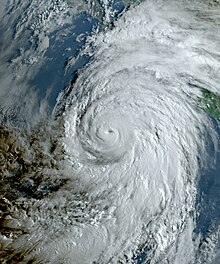 Hilary at Category 4 strength while paralleling the western coast of Mexico on August 18 | |
| Meteorological history | |
|---|---|
| Formed | August 16, 2023 |
| Remnant low | August 20, 2023 |
| Dissipated | August 21, 2023 |
| Category 4 major hurricane | |
| 1-minute sustained (SSHWS/NWS) | |
| Highest winds | 140 mph (220 km/h) |
| Lowest pressure | 940 mbar (hPa); 27.76 inHg |
| Overall effects | |
| Fatalities | 3 total |
| Damage | ≥$915 million (2023 USD) |
| Areas affected | Western Mexico, Revillagigedo Islands, Baja California peninsula, Western United States |
Part of the 2023 Pacific hurricane season | |
Hurricane Hilary was a large and powerful Pacific hurricane in August 2023 that brought torrential rainfall and gusty winds to the Pacific Coast of Mexico, the Baja California Peninsula, and the Southwestern United States, resulting in widespread flooding and mudslides. The cyclone was the eighth named storm, sixth hurricane, and fourth major hurricane of the 2023 Pacific hurricane season.[nb 1] Hilary originated from a tropical wave south of Mexico on August 16, and strengthened into a hurricane a day later while paralleling the southwest coast of Mexico. The hurricane underwent rapid intensification, reaching maximum sustained winds of 140 mph (220 km/h) and a central pressure of 940 mbar (27.76 inHg) on August 18, making it a Category 4 on the Saffir-Simpson scale. After environmental conditions became unfavorable, Hilary weakened as it approached land, making landfall as a tropical storm in San Quintín along the western Baja California peninsula, becoming post-tropical before being absorbed into a new system shortly after.
In Mexico, the hurricane's threat caused thousands of people to evacuate to shelters and for ports to close along the coast. In anticipation of "catastrophic and life-threatening flooding", the National Hurricane Center (NHC) issued its first-ever tropical storm warning for Southern California, extending from the Mexico–United States border to just north of Los Angeles.[1] Persistent heavy rainfall, potentially "more than a year’s worth of rain" in some areas, was forecasted. Due to this, flood watches were issued, affecting about 26 million people across four states (Arizona, California, Nevada, and Utah), and the region was placed under a high risk threat for flash flooding by the Weather Prediction Center (WPC).[2][3][4]
In Mexico, the hurricane killed two people due to floodwaters, and left 250 million pesos (US$14.7 million) in damage. The storm left behind flooded roads, mudslides and downed trees in the Baja California peninsula and in Southern California. Some areas of the latter region received up to 600% of their annual rainfall averages for the month of August.[5] The floods killed one person in San Bernardino County, California. Damage in the United States were estimated at US$900 million, much of it in Inyo County, California, where most of the roads in Death Valley National Park were damaged by floods. The park was closed for two months, its longest ever closure. Hilary broke records in four U.S. states for wettest tropical cyclone or its remnants.
Cite error: There are <ref group=nb> tags on this page, but the references will not show without a {{reflist|group=nb}} template (see the help page).
- ^ Shapiro, Emily; Golembo, Max; Peck, Daniel; Pereira, Ivan (August 18, 2023). "Hilary track and updates: 1st ever tropical storm watch issued in Southern California". ABC News. Archived from the original on August 20, 2023. Retrieved August 21, 2023.
- ^ Masters, Jeff; Henson, Bob (August 18, 2023). "California's first Tropical Storm Watch on record as Hurricane Hilary heads for Baja". Haven, Connecticut: Yale Climate Connections. Archived from the original on August 19, 2023. Retrieved August 20, 2023.
- ^ Wulfeck, Andrew (August 18, 2023). "Hurricane Hilary could dump over year's-worth of rainfall in parts of Desert Southwest". FOX Weather. Archived from the original on August 19, 2023. Retrieved August 20, 2023.
- ^ Freedman, Andrew (August 18, 2023). "Category 4 Hurricane Hilary prompts first-ever tropical storm watch for California". Axios. Archived from the original on August 19, 2023. Retrieved August 20, 2023.
- ^ Maureen O’Leary (November 28, 2023). "2023 Atlantic hurricane season ranks 4th for most-named storms in a year". National Oceanic and Atmospheric Administration. Retrieved November 28, 2023.
© MMXXIII Rich X Search. We shall prevail. All rights reserved. Rich X Search
